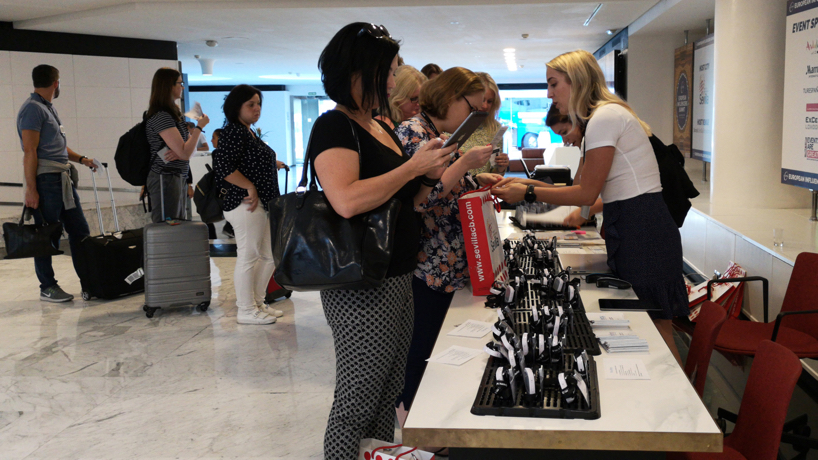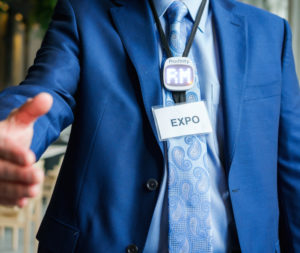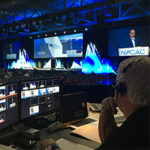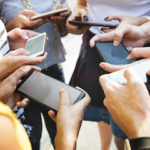
When Sasha Korobko attached a smart badge to her lanyard and began mingling at Networking 2.0 in Chicago earlier this month, she didn’t know what to expect. Hosted by ARA, an organization that aims to attract, retain, and advance women in technology, the event was all about making connections. Korobko was hoping the wearable technology — made by Proxfinity to facilitate introductions between people with shared interests — would help her meet a few colleagues.
A lead QA engineer at Rocketmiles, Korobko said she’s “not good at networking in person.” At every networking event, she told Convene, if she talks to two people, she feels successful.
At the ARA event, Korobko easily multiplied that number, connecting with between 15 and 20 people. She said she was impressed with how the 2-by-2 inch badge helped ease the awkwardness she often feels trying to meet people in business-event settings.
Korobko’s discomfort at networking events isn’t unusual, according to Lisa Carrel, co-founder and CEO of Chicago-based Proxfinity. “It’s totally against our DNA to walk up to a stranger and share something that’s personal,” Carrel said. For some, networking events can feel “threatening,” “off-putting,” and “overwhelming,” she said. “It is not a natural skill that we have.” She cited the example of a nanophysicist and admitted introvert, who was surprised by how the badge increased his ability to connect with others at an event, and called it “the best invention I’ve seen since GPS.”
How It Works
Before the event, Korobko and her fellow attendees filled out a survey with multiple-choice questions of both a professional and social nature. They included: What types of business people are you hoping to meet? What do you like to do in your free time? Their responses were programmed into their smart badges.
The badge was then attached to attendees’ lanyards before the networking event. As they mingled, whenever someone with a common interest came near Korobko, both her badge and her fellow attendee’s badge lit up with each another’s initials. A colored light in the same corner of both badges also flashed, identifying the common interest and prompting a conversation starter.

“The idea is to connect on a personal level and then you can go anywhere, really,” Carrel said. “You can get to know one another. It’s more organic in how you’re connecting and learning about one another’s business. It’s more fun and not as salesy.”
Those attendees who are more concerned about protecting their privacy than making connections can opt out of sharing their personal information with Proxfinity. Plus, Proxfinity is working to achieve full compliance with the GDPR and other privacy regulations, Carrel said, and participants already can request to have their data destroyed and their profile erased after the event concludes.
Many times those who initially opt out of answering the surveys change their minds once they are on site, Carrel said. “Generally there’s so much value in what they get out of it that that is more important to them,” she said, “than the fact that we know what they like to do in their free time.”
Since its first activation three years ago, Proxfinity has helped connect professionals at such companies as Deloitte, Wrigley, NationalMI, Wintrust Mortgage, Cielo, and Accenture. Just last week, Proxfinity was put to use by participants at PCMA’s second European Influencer’s Summit in Seville, Spain.
Extended Benefits
Beyond serving as a high-tech icebreaker, Proxfinity helps event organizers and attendees glean potentially valuable information after the event.
If badges are in close proximity for at least 30 seconds, Proxfinity counts that meeting as a connection. The company can analyze the data from those connections in several different ways to provide the event organizer with solid numbers that demonstrate the ROI for participants — including suppliers — to attend.
Proxfinity can break down the data by demographics, and participants’ home locations, interests, and professions — whatever the hosting group wants to measure by asking in the pre-event survey.

For example, PCMA’s European Influencer’s Summit participants were asked, among other questions, to identify as suppliers or event producers. After the numbers are crunched, PCMA will be able to quantify the connections made between buyers and suppliers during the summit.
“That’s valuable information,” Carrel said. “You can use that data and say, ‘Hey, I’ve got numbers to back this up.’ People want to know that if they’re signing up for an event they are going to get something out of it.”
In a case study Proxfinity produced last year in partnership with the University of Chicago Booth School of Business, connections at a networking event for a professional group increased 50 percent using the Proxfinity badge over the connections made by a similar group at a similar event without the smart badge. New connections — those made by complete strangers at the event — increased 300 percent, Proxfinity co-founderChristine Hutchinson told Convene.
While “it’s great to meet all these people,” Carrel said, it’s not of much use “if there’s no next step.” So after events, participants receive an email from Proxfinity with a link to a portal that stores contact information — name, employer, role, email, and phone number — for their connections so they can easily follow up. They are also able to see how long their interactions lasted.
Some of Proxfinity’s clients have used the tech for more than networking events. Angela Kabbes, principal at Tandem Events and Communications, tapped Proxfinity to help a large pharmaceutical client bring disparate employees together from various locations and departments at two events. The idea was to encourage cross-functional groups to better understand what everyone else does so they could work together and ultimately improve business outcomes.
“Both meetings went really well,” Kabbes said, and 90 percent of the respondents to post-event questions said Proxfinity was a great tool. For one event, Kabbes and the pharma client used the survey responses to strategically seat employees from around the world next to each other. That enabled them to work through business solutions with colleagues they likely would not have otherwise realized could be valuable collaborators. By using technology in this way, Kabbes said, you can really “better your business.”



